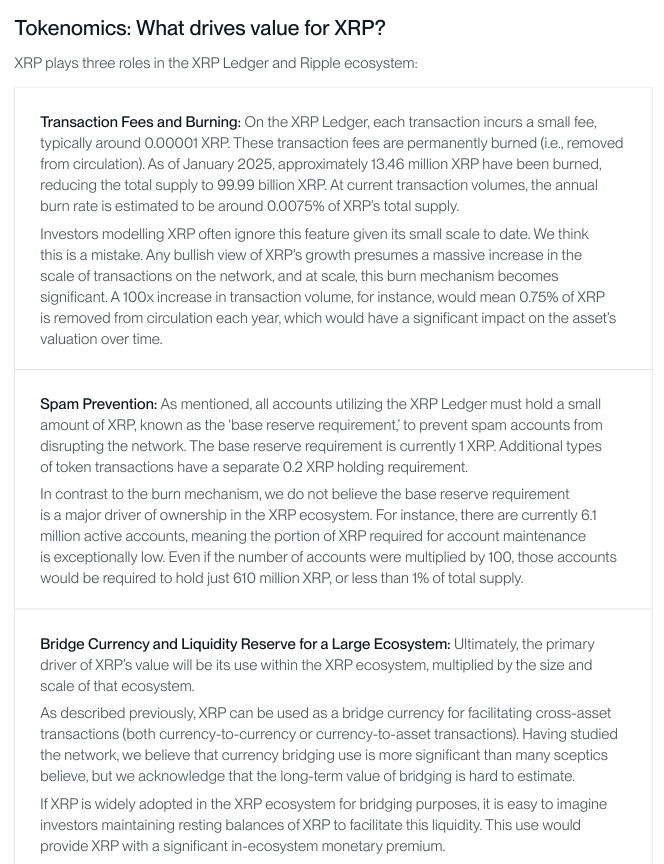Prominent asset manager Bitwise Investment has addressesd burgeoning concerns about XRP’s real use case in the XRP Ledger and Ripple ecosystem.
WrathofKahneman (WOK), an influential figure in the XRP community, shared a Bitwise report highlighting the “clear, succinct, and relevant” description of XRP’s role in the Ripple ecosystem. The piece deeply explains XRP as a digital asset and what drives its value.
XRP’s Three Major Functions and Impact on Valuation
First, Bitwise highlighted the difference between XRP, the XRP Ledger, and Ripple. For context, the XRP Ledger is a blockchain running with the proof of authority consensus, built to enable swift and efficient payments.
Meanwhile, XRP is the native token of the XRP Ledger, and Ripple is a private company that acts as one of the contributors of the XRP Ledger, leveraging the network and its native token XRP for its cross-border payment business.
Furthermore, the piece stressed three key roles that XRP plays in the ecosystem and how it derives its value. First, as the native token of the XRPL network, users pay fees for each transaction in the digital asset.
Remarkably, the XRP Ledger is programmed to burn realized transaction fees permanently, effectively reducing the asset’s total supply. At the reporting time, this mechanism has effectively incinerated 13.85 million XRP, cutting the supply to 99.986 billion XRP. Notably, the current transaction volume’s annual burn rate is 0.0075% of XRP’s total supply.
Now, how does this drive XRP’s price? With the Q1 2025 transaction count on the XRP Ledger averaging 1.17 million per day, an increased number will consequently impact the XRP burn rate.
Bitwise emphasized that a notable surge in the adoption of the XRPL blockchain will make the burn rates more significant. For instance, a 100x growth in volume will increase annual incineration rates to 0.75% of XRP’s total supply, which could impact prices in the long term.
Spam Protection and Bridging Utility
Secondly, the report shared that XRP has utility as spam protection for the XRP Ledger. To avoid the creation of multiple junk accounts on the network, the network placed a base reserve requirement of 1 XRP. Notably, the initial requirement was 10 XRP before the December 2024 amendment, which slashed the minimum balance by 90%.
Meanwhile, Bitwise noted that the base reserve requirement is not a notable driver for XRP’s ownership or demand. With about 6.1 million active addresses on the Ledger, the portion of XRP locked in for account maintenance would have minimal impact on supply, even with a 100x increase.
Finally, the exposition mentioned XRP’s bridging currency status as its most important function in the ecosystem and the one it sees as a major driver for the asset’s price.
With Ripple’s core business tied around large-scale currency-to-currency and currency-to-asset bridging through the XRP Ledger, XRP’s adoption as a central bridging asset would encourage institutional clients to hold XRP, significantly impacting supply and prices.

Interestingly, Ripple is planning to compete with SWIFT, the largest payment messaging solution in the world. Analysts have predicted that if the financial technology firm processes just 15% of SWIFT’s daily transaction volume, its prices will explode to $25.68.
Nonetheless, XRP’s utility as a central bridging asset faces shared attention from the Ripple USD stablecoin launched in December. While Ripple has assured that the dollar-pegged token will not replace XRP, it will impact the number of transactions processed with the XRPL native token.
DisClamier: This content is informational and should not be considered financial advice. The views expressed in this article may include the author's personal opinions and do not reflect The Crypto Basic opinion. Readers are encouraged to do thorough research before making any investment decisions. The Crypto Basic is not responsible for any financial losses.



